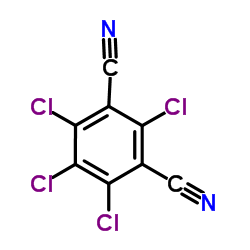Chlorothalonil

Chlorothalonil structure
|
Common Name | Chlorothalonil | ||
|---|---|---|---|---|
| CAS Number | 1897-45-6 | Molecular Weight | 265.911 | |
| Density | 1.7±0.1 g/cm3 | Boiling Point | 350.5±37.0 °C at 760 mmHg | |
| Molecular Formula | C8Cl4N2 | Melting Point | 250-251ºC | |
| MSDS | Chinese USA | Flash Point | 153.8±20.7 °C | |
| Symbol |




GHS05, GHS06, GHS08, GHS09 |
Signal Word | Danger | |
|
Effects of seven antifouling compounds on photosynthesis and inorganic carbon use in sugar kelp Saccharina latissima (Linnaeus).
Arch. Environ. Contam. Toxicol. 63(3) , 365-77, (2012) Macroalgae depend on carbon-concentrating mechanisms (CCMs) to maintain a high photosynthetic activity under conditions of low carbon dioxide (CO(2)) availability. Because such conditions are prevalent in marine environments, CCMs are important for upholding ... |
|
|
Development and validation of one-step ultrasound-assisted extraction for simultaneous determination of multiclass fungicides in soils.
J. AOAC Int. 98(1) , 192-200, (2015) A rapid, efficient, and simple one-step ultrasound-assisted extraction (UAE) method was developed for the analysis of seven fungicides (cymoxanil, metalaxyl, mandipropamid, folpet, chlorothalonil, kresoxim-methyl, and famoxadone) in horticultural soils. Analy... |
|
|
Photoreduction of chlorothalonil fungicide on plant leaf models.
Environ. Sci. Technol. 45(22) , 9582-9, (2011) Photodegradation is seldom considered at the surface of vegetation after crop spraying. Chlorothalonil, a broad-spectrum foliar fungicide with a very widespread use worldwide, was considered. To represent the waxy upper layer of leaves, tests were performed w... |
|
|
Measuring Leaf Penetration and Volatilization of Chlorothalonil and Epoxiconazole Applied on Wheat Leaves in a Laboratory-Scale Experiment.
J. Environ. Qual. 44 , 1782-90, (2015) Estimation of pesticide volatilization from plants is difficult because of our poor understanding of foliar penetration by pesticides, which governs the amount of pesticide available for volatilization from the leaf surface. The description of foliar penetrat... |
|
|
Washing effects of limonene on pesticide residues in green peppers.
J. Sci. Food Agric. 93(12) , 2917-21, (2013) The presence of pesticide residues in food has caused much concern. The low health risks and environmental impacts of limonene make it a very interesting solvent for use in green chemistry. Washing effects of limonene on pesticide residues of methyl chlorpyri... |
|
|
Recent advances in the biodegradation of chlorothalonil.
Curr. Microbiol. 63(5) , 450-7, (2011) Chlorothalonil (TPN; 2,4,5,6-tetrachloroisophthalonitrile) has been widely used as a broad-spectrum chlorinated aromatic fungicide and its application resulted in global pollution commonly detected in the diverse ecosystems. Recently, microbial degradation of... |
|
|
Diabetic ketoacidosis following chlorothalonil poisoning.
Occup. Environ. Med. 71(5) , 382, (2014)
|
|
|
Contact dermatitis caused by chlorothalonil on imported roses: irritant or allergic reaction?
Contact Dermatitis 65(1) , 50-1, (2011)
|
|
|
Removal of chloropyrifos ethyl, tetradifon and chlorothalonil pesticide residues from citrus by using ozone.
J. Hazard. Mater. 241-242 , 287-300, (2012) The removal of chloropyrifos ethyl, tetradifon and chlorothalonil pesticide residues from the lemon, orange and grapefruit matrices were achieved by ozonation. All of chlorothalonil residues adsorbed onto the orange matrix were completely removed after 5 min ... |
|
|
Interactive effects of pesticide mixtures, predators, and environmental regimes on the toxicity of two pesticides to red-eyed tree frog larvae.
Environ. Toxicol. Chem. 32(10) , 2379-86, (2013) Global amphibian declines have many corroborative causes, and the use of pesticides in agriculture is a likely contributor. In places with high pesticide usage, such as Costa Rica, agrochemical pesticides may interact with other factors to contribute to rapid... |